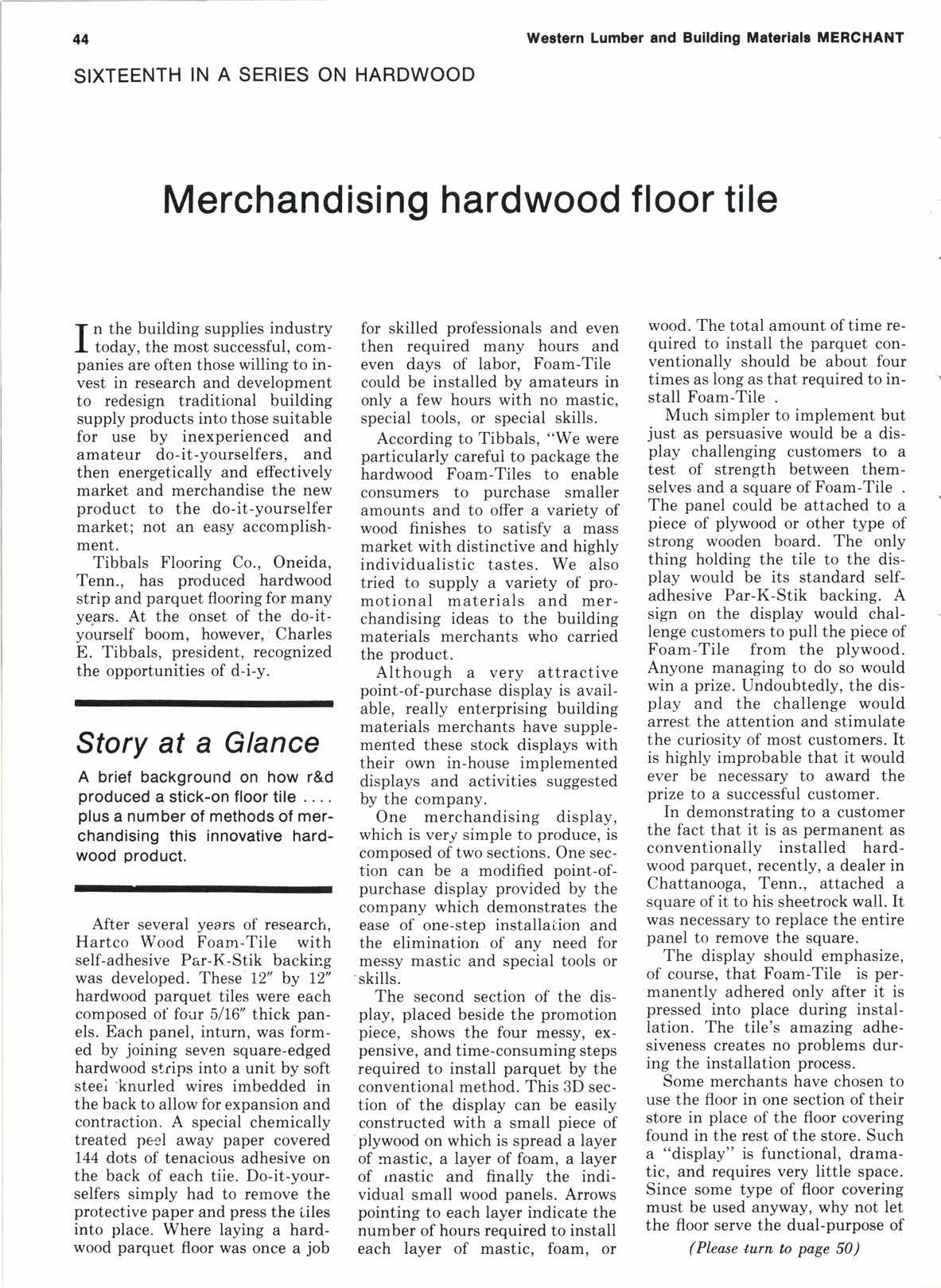
3 minute read
Merchandising hardwood floor tile
J n the building supplies industry
I todav. the most successful. companies are often those willing to invest in research and development to redesign traditional building supply products into those suitable for use by inexperienced and amateur do-it-yourselfers, and then energetically and effectively market and merchandise the new product to the do-it-yourselfer market; not an easy accomplishment.
Tibbals Flooring Co., Oneida, Tenn., has produced hardwood strip and parquet flooring for many yeprs. At the onset of the do-ityourself boom, however,' Charles E. Tibbals, president, recognized the opportunities of d-i-y.
Story at a Glance
A brief background on how r&d produced a stick-on floortile .... plus a number of methods of merchandising this innovative hardwood product.
for skilled professionals and even then required many hours and even days of labor, Foam-Tile could be installed by amateurs in only a few hours with no mastic, special tools, or special skills.
According to Tibbals, "We were particularly carefui to package the hardwood Foam-Tiles to enable consumers to purchase smaller amounts and to offer a variety of wood finishes to satisfy a mass market with distinctive and highly individualistic tastes. We also tried to supply a variety of promotional materials and merchandising ideas to the building materials merchants who carried the product.
Although a very attractive point-of-purchase display is available, really enterprising building materials merchants have supplemedted these stock displays with their own in-house implemented displays and activities suggested by the company.
wood. The total amount of time required to install the parquet conventionally should be about four times as long as that required to install Foam-Tile
Much simpler to implement but just as persuasive would be a display challenging customers to a test of strength between themselves and a square of Foam-Tile The panel could be attached to a piece of plywood or other type of strong wooden board. The only thing holding the tile to the display would be its standard selfadhesive Par-K-Stik backing. A sign on the display would challenge customers to pull the piece of Foam-Tile from the plywood. Anyone managing to do so would win a prize. Undoubtedly, the display and the challenge would arrest the attention and stimulate the curiosity of most customers. It is highly improbable that it would ever be necessary to award the prize to a successful customer.
After several years of research, Hartco Wood Foam-Tile with self-adhesive Par-K-Stik backing was developed. These 12" by 12" hardwood parquet tiles were each composed, ot' four 5/16" thick panels. Each panel, inturn, was formed by joining seven square-edged hardwood st"rips into a unit by soft steei 'knurled wires imbedded in the back to allow for expansion and contraction. A special chemically treated peel away paper covered 144 dots of tenacious adhesive on the back of each tiie. Do-it-yourselfers simply had to remove the protective paper and press the i,iles into place. Where laying a hardwood parquet floor was once a job
One merchandising display, which is very simple to produce, is composed of two sections. One section can be a modified point-ofpurchase display provided by the company which demonstrates the ease of one-step installaiion and the eliminatiorr of any need for messy mastic and special tools or skills.
The second section of the display, placed beside the promotion piece, shows the four messy, expensive, and time-consuming steps required to install parquet by the conventional method. This 3D section of the display can be easily constructed with a small piece of plywood on which is spread a layer of rnastic, a layer of foam, a layer of rnastic and finally the individual small wood panels. Arrows pointing to each layer indicate the number of hours required to install each layer of mastic, foam, or
In demonstrating to a customer the fact that it is as permanent as conventionally installed hardwood parquet, recently, a dealer in Chattanooga, Tenn., attached a square of it to his sheetrock wall. It was necessary to replace the entire panel to remove the square.
The display should emphasize, of course, that Foam-Tile is permanently adhered only after it is pressed into place during installation. The tile's amazing adhesiveness creates no problems during the installation process.
Some merchants have chosen to use the floor in one section of their store in place of the floor covering found in the rest of the store. Such a "display" is functional, dramatic, and requires very little space. Since some type of floor covering must be used anyway, why not let the floor serve the dual-purpose of (Please turn to page 50)









